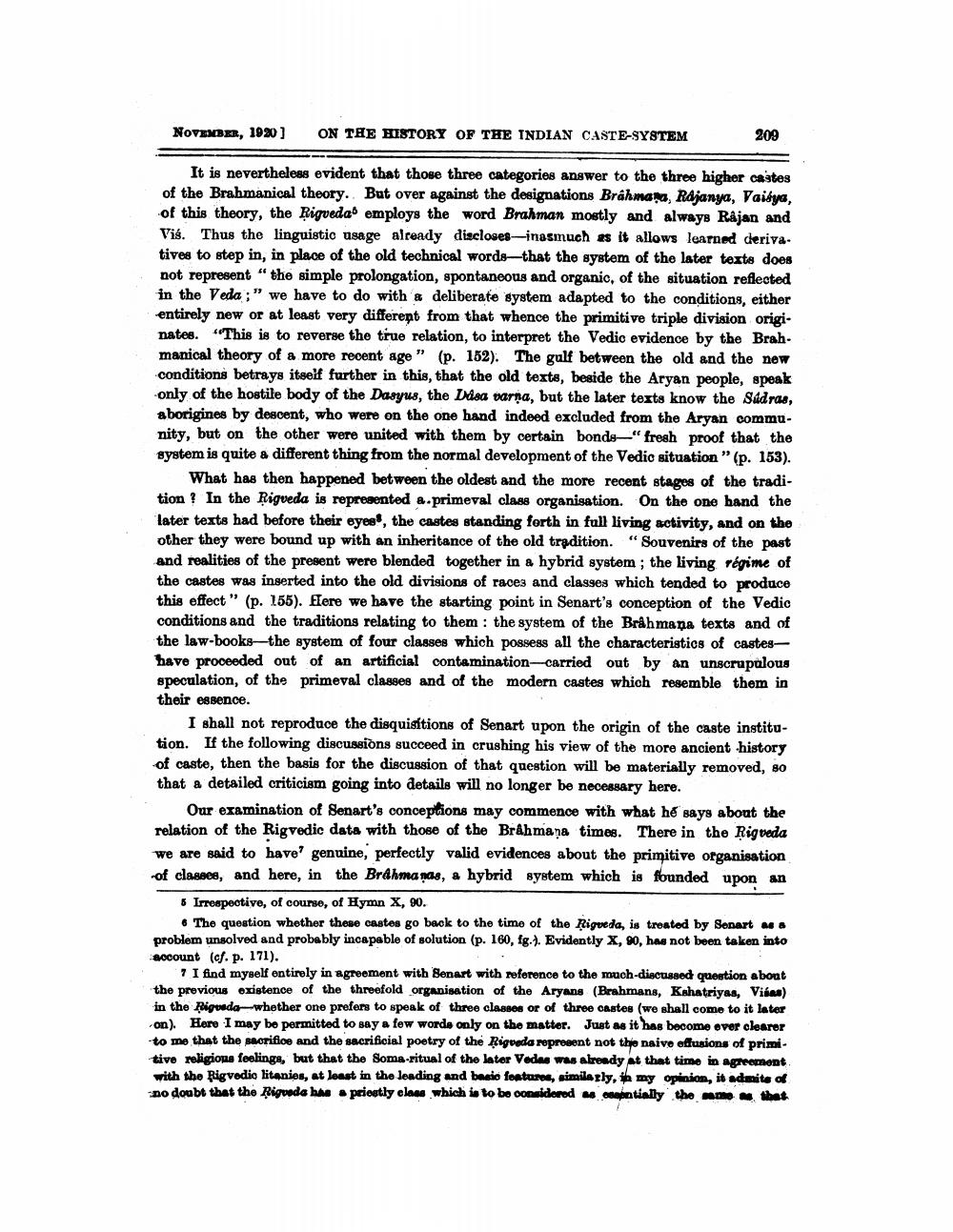________________
NOVEMBER, 1920] ON THE HISTORY OF THE INDIAN CASTE-SYSTEM
It is nevertheless evident that those three categories answer to the three higher castes of the Brahmanical theory. But over against the designations Brahmana, Rajanya, Vaidya, of this theory, the Rigveda employs the word Brahman mostly and always Rajan and Vis. Thus the linguistic usage already discloses inasmuch as it allows learned derivatives to step in, in place of the old technical words-that the system of the later texts does not represent "the simple prolongation, spontaneous and organic, of the situation reflected in the Veda:" we have to do with a deliberate system adapted to the conditions, either entirely new or at least very different from that whence the primitive triple division originates. "This is to reverse the true relation, to interpret the Vedic evidence by the Brahmanical theory of a more recent age" (p. 152). The gulf between the old and the new conditions betrays itself further in this, that the old texts, beside the Aryan people, speak only of the hostile body of the Dasyus, the Dása varna, but the later texts know the Súdras, aborigines by descent, who were on the one hand indeed excluded from the Aryan community, but on the other were united with them by certain bonds-"fresh proof that the system is quite a different thing from the normal development of the Vedic situation" (p. 153).
209
What has then happened between the oldest and the more recent stages of the tradition? In the Rigveda is represented a.primeval class organisation. On the one hand the later texts had before their eyes, the castes standing forth in full living activity, and on the other they were bound up with an inheritance of the old tradition. "Souvenirs of the past and realities of the present were blended together in a hybrid system; the living régime of the castes was inserted into the old divisions of races and classes which tended to produce this effect" (p. 155). Here we have the starting point in Senart's conception of the Vedic conditions and the traditions relating to them: the system of the Brahmana texts and of the law-books-the system of four classes which possess all the characteristics of casteshave proceeded out of an artificial contamination-carried out by an unscrupulous speculation, of the primeval classes and of the modern castes which resemble them in their essence.
I shall not reproduce the disquisitions of Senart upon the origin of the caste institution. If the following discussions succeed in crushing his view of the more ancient history of caste, then the basis for the discussion of that question will be materially removed, so that a detailed criticism going into details will no longer be necessary here.
Our examination of Senart's conceptions may commence with what he says about the relation of the Rigvedic data with those of the Brahmana times. There in the Rigveda we are said to have genuine, perfectly valid evidences about the primitive organisation of classes, and here, in the Brahmanas, a hybrid system which is founded upon an
5 Irrespective, of course, of Hymn X, 90.
The question whether these castes go back to the time of the Rigveda, is treated by Senart as a problem unsolved and probably incapable of solution (p. 160, fg.). Evidently X, 90, has not been taken into account (cf. p. 171).
7 I find myself entirely in agreement with Senart with reference to the much-discussed question about the previous existence of the threefold organisation of the Aryans (Brahmans, Kshatriyas, Visas) in the Rigveda whether one prefers to speak of three classes or of three castes (we shall come to it later on). Here I may be permitted to say a few words only on the matter. Just as it has become ever clearer to me that the sacrifice and the sacrificial poetry of the Rigveda represent not the naive effusions of primitive religious feelings, but that the Soma-ritual of the later Vedas was already at that time in agreement with the Rigvedic litanies, at least in the leading and basic features, similarly, in my opinion, it admits of no doubt that the Rigveda has a priestly class which is to be considered as essentially the same as that




